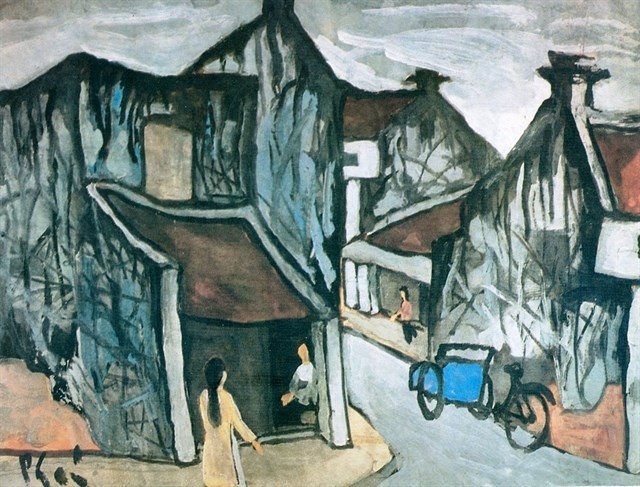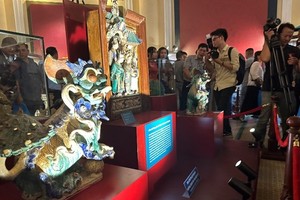
That’s a common idea shared by dozens of participants at a workshop held on July 18 the task of authenticating fine art and photographic works.
The event, which was hosted by the Ministry of Culture, Sports and Tourism’s Fine Arts, Photography and Exhibition Department, was attended by culture managers, painters, photographers, fine art and photography researchers.
“Checking the authenticity of fine art works is a new task in Vietnam,” said Vi Kien Thanh, director of the department.
“Staff at the Centre for Expertising Fine Art Works set up last year have almost no experience in the field while the centre has no proper equipment,” he said.
“In the meantime, domestic fine arts have developed with lots of exchange and trading activities,” he said.
“Hence the increasing demand for checking authenticity of the artworks by collectors, museums and individuals,” he said.
Thanh admitted that the task of checking authenticity of fine art works is challenging, including the lack of proper legal articles on the task.
“Vietnamese people tend to doubt or don’t want to recognise others’ capabilities. They also do not want to recognise referees, which is another hindrance,” he said.
The centre has no proper equipment, so the task relies on human beings and machines owned by the Ministry of Public Security’s Criminal Science Institute.
“These are great obstacles that cannot be overcome soon,” he said.
Data bank on artists
Deputy Director of the Vietnam Fine Arts Museum Bui Thi Thanh Mai said the success of the art market depends on the trust in the authenticity of art works.
“Recent scandals caused by fake paintings damage Vietnamese fine art,” she said.
Mai said one of the main reasons for the appearance of more fake paintings is that there are not enough materials to prove the paintings are originals.
“There is no lab in the country to analyse details of the paintings to examine the authenticity of the work,” she said.
“For a long time, many painters did not pay attention to promoting their styles or frequently used materials, so other people could not figure out whether a painting was original or not,” she said.
“The lack of information has increased the number of fake works,” she added.
“I think materials on the origin of art works are very important for checking the authenticity of artworks,” she said. “This is the first step in the task of expertising fine art works.”
Mai suggested painters and photographers themselves should contribute information on their works to a data bank, which people can easily search.
“It’s a way to ensure their property and wisdom as well as a way to advertise their name to the public most effectively. It’s like international artists have been doing,” she said.
Collector Son Truong agreed with Mai’s opinion on setting up a data bank on painters and photographers to protect their copyright.
He suggest the centre should use the State budget to train staff in authentication.
He set up the website vanlangcentre.com.vn, offering information on 32 Vietnamese contemporary artists, whose paintings he possesses.
Duong Thu Hang, owner of Hanoi Studio Gallery, also agreed with Mai’s suggestion.
She spoke about her own experience working with Korean collectors.
She said many of her Korean friends said collectors bought all paintings by Bui Xuan Phai (1920-1988) in Vietnamese galleries in the 1980s and 1990s, and there are now no more authentic paintings by the artist in Vietnam.
At the end of the workshop, Thanh confirmed that the department will continue to run the centre until some individual or organisation takes up the task.
“A State-run agency like our department should not do this task to ensure objectivity and transparency,” he said.
“The department will immediately gather artists’ information for the data bank to ease authenticity of artworks in the future,” he said.
The department will also adjust the price for authentication services as in fact the expense is sometimes higher than the price of the painting.
The centre was set up in December 2018 to act as a referee in the fine art market after more fake paintings were discovered.
The event, which was hosted by the Ministry of Culture, Sports and Tourism’s Fine Arts, Photography and Exhibition Department, was attended by culture managers, painters, photographers, fine art and photography researchers.
“Checking the authenticity of fine art works is a new task in Vietnam,” said Vi Kien Thanh, director of the department.
“Staff at the Centre for Expertising Fine Art Works set up last year have almost no experience in the field while the centre has no proper equipment,” he said.
“In the meantime, domestic fine arts have developed with lots of exchange and trading activities,” he said.
“Hence the increasing demand for checking authenticity of the artworks by collectors, museums and individuals,” he said.
Thanh admitted that the task of checking authenticity of fine art works is challenging, including the lack of proper legal articles on the task.
“Vietnamese people tend to doubt or don’t want to recognise others’ capabilities. They also do not want to recognise referees, which is another hindrance,” he said.
The centre has no proper equipment, so the task relies on human beings and machines owned by the Ministry of Public Security’s Criminal Science Institute.
“These are great obstacles that cannot be overcome soon,” he said.
Data bank on artists
Deputy Director of the Vietnam Fine Arts Museum Bui Thi Thanh Mai said the success of the art market depends on the trust in the authenticity of art works.
“Recent scandals caused by fake paintings damage Vietnamese fine art,” she said.
Mai said one of the main reasons for the appearance of more fake paintings is that there are not enough materials to prove the paintings are originals.
“There is no lab in the country to analyse details of the paintings to examine the authenticity of the work,” she said.
“For a long time, many painters did not pay attention to promoting their styles or frequently used materials, so other people could not figure out whether a painting was original or not,” she said.
“The lack of information has increased the number of fake works,” she added.
“I think materials on the origin of art works are very important for checking the authenticity of artworks,” she said. “This is the first step in the task of expertising fine art works.”
Mai suggested painters and photographers themselves should contribute information on their works to a data bank, which people can easily search.
“It’s a way to ensure their property and wisdom as well as a way to advertise their name to the public most effectively. It’s like international artists have been doing,” she said.
Collector Son Truong agreed with Mai’s opinion on setting up a data bank on painters and photographers to protect their copyright.
He suggest the centre should use the State budget to train staff in authentication.
He set up the website vanlangcentre.com.vn, offering information on 32 Vietnamese contemporary artists, whose paintings he possesses.
Duong Thu Hang, owner of Hanoi Studio Gallery, also agreed with Mai’s suggestion.
She spoke about her own experience working with Korean collectors.
She said many of her Korean friends said collectors bought all paintings by Bui Xuan Phai (1920-1988) in Vietnamese galleries in the 1980s and 1990s, and there are now no more authentic paintings by the artist in Vietnam.
At the end of the workshop, Thanh confirmed that the department will continue to run the centre until some individual or organisation takes up the task.
“A State-run agency like our department should not do this task to ensure objectivity and transparency,” he said.
“The department will immediately gather artists’ information for the data bank to ease authenticity of artworks in the future,” he said.
The department will also adjust the price for authentication services as in fact the expense is sometimes higher than the price of the painting.
The centre was set up in December 2018 to act as a referee in the fine art market after more fake paintings were discovered.
























